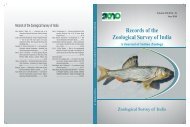Vol. 111 - Part I - Zoological Survey of India
Vol. 111 - Part I - Zoological Survey of India
Vol. 111 - Part I - Zoological Survey of India
You also want an ePaper? Increase the reach of your titles
YUMPU automatically turns print PDFs into web optimized ePapers that Google loves.
MURMU et al. : A population survey <strong>of</strong> Rhesus monkeys and Hanuman langurs <strong>of</strong> Puri......Orissa, <strong>India</strong> 19<br />
During 1978 survey 9 groups <strong>of</strong> rhesus monkey with<br />
a total <strong>of</strong> 178 individuals were recorded. Out <strong>of</strong> 9 groups<br />
one group containing 3 monkeys were recorded at<br />
Baruni hill forests where the social composition was<br />
not mentioned. The remaining 8 social groups having<br />
175 monkeys <strong>of</strong> which 29 were adult males; 62 were<br />
adult females; 51 were juveniles and 33 were infants.<br />
These monkeys were found inhabiting in temples,<br />
forests and in villages (Table-2). The mean density <strong>of</strong><br />
monkeys in these three habitats is shown in Fig. 5. The<br />
240<br />
200<br />
160<br />
120<br />
80<br />
40<br />
0<br />
average group size excluding the Baruni group was<br />
10.78 ± 8.83 monkeys <strong>of</strong> which 3.22 ± 1.41 was adult<br />
males; 6.89 ± 2.90 were adult females; 5.67 ± 2.64 was<br />
juveniles and 3.67 ± 2.13 were infants. The percentage<br />
composition consisted <strong>of</strong> 16.57% adult males, 35.43%<br />
adult females, 29.15% juveniles and 18.85% infants.<br />
About 53% females were carrying infants. The ratio <strong>of</strong><br />
adult males to adult females was 1 : 2.13 and adult<br />
females to juveniles and infants ratios were 1 : 0.82 and<br />
1 : 0.53 respectively.<br />
Table-1. Distribution and social composition <strong>of</strong> Rhesus macaque at Puri and Khurda District during–2004.<br />
Habitat Total Males Females Juveniles Infants<br />
Temple 234 28 91 54 61<br />
Town 5 1 2 0 2<br />
Forest 214 26 107 38 43<br />
Village 48 6 24 8 10<br />
Table-2. Distribution and social composition <strong>of</strong> Rhesus macaque at Puri and Khurda district–1978.<br />
Habitat Total Males Females Juveniles Infants<br />
Temple 73 14 27 20 12<br />
Forest 74 12 22 20 17<br />
Village 31 3 13 11 4<br />
Total Males Females Juveniles Infants<br />
Temple<br />
Town<br />
Forest<br />
Village<br />
Fig. 1. Distribution & Social composition <strong>of</strong> Rhesus macaque<br />
at Puri & Khurda districts in 2004.<br />
HANUMAN LANGURS<br />
Result from the survey revealed the sightings <strong>of</strong><br />
110 groups <strong>of</strong> Hanuman langur, <strong>of</strong> which 3 were all<br />
male bands and 3 solitary males and rest 104 were social<br />
groups (Plate-I). The 110 groups consisted <strong>of</strong> 2114<br />
langurs. The distribution <strong>of</strong> social langur groups is<br />
shown in Fig. 2. This provides a population estimate <strong>of</strong><br />
0.045 groups/km2 which comprised <strong>of</strong> 0.88 langurs/km2 .<br />
The group size varied from 4 to 64 individuals. The 3<br />
all male bands consisted <strong>of</strong> 14 langurs and all these<br />
inhabited the villages close to bisexual groups in Puri<br />
and Khurda districts.<br />
80<br />
60<br />
40<br />
20<br />
0<br />
Total Male Female Juvenile Infant<br />
Temple<br />
Forest<br />
Village<br />
Fig. 2. Distribution & Social composition <strong>of</strong> Rhesus macaque<br />
at Puri & Khurda districts–1978.<br />
The 104 social groups consisted <strong>of</strong> 2097 langurs,<br />
which composed <strong>of</strong> 228 adult males; 1031 adult females;<br />
438 juveniles and 400 infants. The mean group size<br />
was 20.16 ± 1.22 individuals (Table-3). The adult males<br />
to adult females ratio was 1 : 4.5 and adult females to<br />
sub-adults ratio was 1 : 0.81. About 38.7% females were<br />
having infants. These 104 social hanuman langur<br />
groups were distributed in 4 habitat categories—<br />
villages, forests, temples and towns. The mean density<br />
<strong>of</strong> these groups is shown in Fig. 2. The habitatwise<br />
distribution <strong>of</strong> langurs is given in Table-3.
















